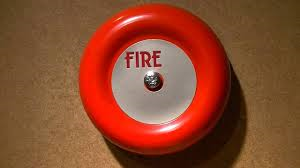 Imagine this scenario. You are about to deliver your 20 minute pitch to a client when the fire bell goes off. You are informed that it is only a drill and you decide to seize the moment.
Imagine this scenario. You are about to deliver your 20 minute pitch to a client when the fire bell goes off. You are informed that it is only a drill and you decide to seize the moment.
You open your mouth: “Before we head out, can I please take 30 secs to tell you the most important thing you need to know ?”You proceed to outline in 30 secs the value-added knock-out message of your 20 minute speech.
Many of you have used our Fire Bell Test, tool, outlined above, which asks you to envisage just this scenario. We give you 30 seconds to think of – and write down- the most important key message of your pitch. Then we give you another 30 secs to think of the second most important one, and finally, because we’re a generous bunch here at GPB, the third. As if by magic, you have your key messages. The logical progression of this is what we have come to call the Fire Bell Pitch (or FBP). This is a pithy, impactful pitch that exists in a variety of lengths between 30 seconds and 2 minutes. It contains your key message(s) crafted in the way outlined above, and it hooks your audience, leaving them wanting to hear more.
Fire Bell, to be used in this test…
The FBP is similar to the notorious “elevator pitch”, but we prefer our version because it suggests that the difficulties are heightened.
Instead of pleasant elevator music, you have the piercing ringing of an alarm bell; instead of the calm shelter of a corporate lift, you are distracted by the bustle of other staff exiting down the fire escape! Simply put, the challenge is that much bigger so you have to be even more effective in your pitch. FBPs are unleashed in all manner of circumstances: indeed, it is their flexibility that makes them so attractive. You will have many different audiences: you might strike up a conversation with a potential client on a train, you might be asked by your boss what you think would make the company a better place in which to work, you might be interviewed by the media for your views on a particular subject.
Of course, tied to this, you have an almost infinite variety of possible locations. You should be able to produce an FBP anytime, anywhere, and with anyone. What, then, are the keys to an impactful FBP? Well, there are the obvious points – you must aim to be concise, clear, snappy, persuasive and memorable. But we think you should keep a few other things firmly in mind to achieve these goals:
1. Keep your intention locked in your brain. Remember, you are not pitching to get the person to buy your service or product right there and then. You may be pitching to set up the next meeting with this person or get them to agree to a call next week. Or you may simply be reiterating key messages to enhance brand reputation for the future (think politicians!). Remember, it’s only step one: leave them wanting to hear more, but know what step two looks likes.
2. Balance is essential. You need to say enough that your pitch is intriguing and compelling, but not so much as to make your listener bored or annoyed.
Too much or too little, and you’re out of the game. Balance is also vital when it comes to the broad scope versus use of detail: you need present your idea through a wide enough lens that the big picture is easily grasped, but you also need to provide enough concrete evidence or examples to demonstrate clearly the value of your proposition.
3. Language is key. Use of language, such as effective rhetorical tools, will make a huge difference to how punchy and sticky your messages are. But make sure you don’t sound gimmicky like an advertising jingle (nobody wants to feel they are being sold to in that way): ensure your rhetorical tools are embedded deep within your content and not just sitting on top of your words.
- Relevance will make you stand out. Having a good idea, product or service is one thing, but having an idea, product or service that is good for the person to whom you are pitching is another thing altogether. Make each FBP specific to the individual with whom you are speaking and ensure you spell out clearly the benefits to them.
There have been several examples recently of fire bell pitches, but let’s look at one in particular that made the headlines. You may have heard the Leader of the Green Party, Natalie Bennett, fail to make the most of her opportunity on a radio interview with Nick Ferrari on LBC Radio on 24th February 2015. (see their website, details below, for a full transcript). Media interviews are wonderful platforms from which to deliver your FBP that consequently reaches thousands of listeners – unfortunately, Natalie Bennett failed to impress as the holes in her knowledge of her policies came under serious fire. Ferrari’s questions probed how the Green Party would fund the building of 500,000 new social rent homes. Bennett’s answers got progressively worse. Long silences, an inability to do the maths and a failure to bridge effectively to any key messages characterised her bumpy performance.
What should she have done differently?
Well, the FBP is only your friend if know it inside-out and back-to-front. You have to know it and you have rehearse it; and as you do, you have to listen carefully to the actual words you say as you are rehearsing. This will give you the knowledge and confidence to tease the points apart or weld them together as and when need demands. (Remember, I said it comes in a variety of lengths.) Fundamental to this ability is knowing the pithy but concrete detail of your material: the flashiest, punchiest FBP is of no use if it’s built on gaping holes in between unsubstantiated estimates.
So, build your FBP strong, and practice it well: only then can you bend it effectively to your will and, hopefully, reap the desired rewards.
Richard Keith, Consultant at GPB



